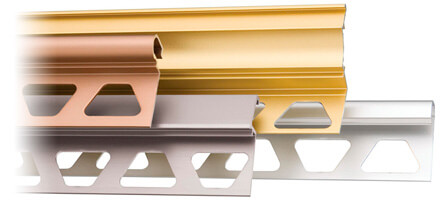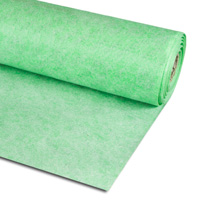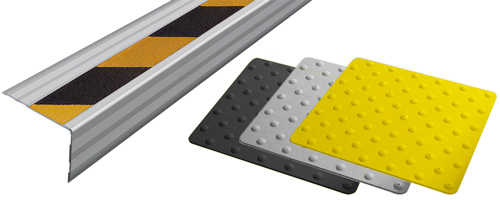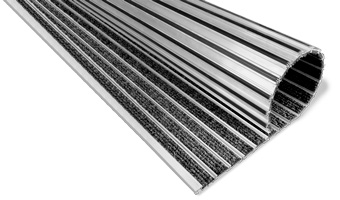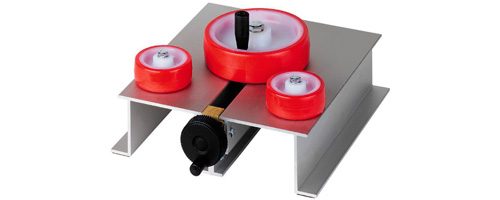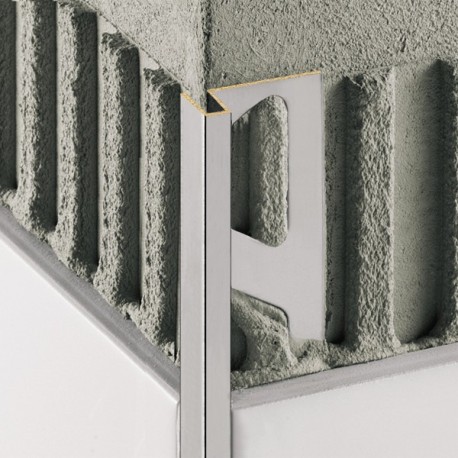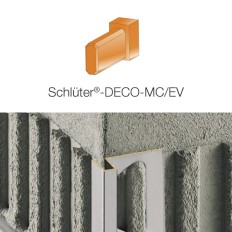Schlüter DECO are profiles for tiles made of metal of different types with a visible width of 6 mm for a decorative design of joints in ceramic coatings. These decorative profiles, in addition to meeting functional requirements, meet high demands in terms of design and aesthetics, eg. ex. in exhibition halls, representative buildings, galleries or fair stands. Schlüter DECO tile profiles are also suitable as a finish profile and as a separation for different types of coatings, eg. ex. in the transition from ceramic tile flooring to carpet or parquet. Schlüter DECO not only provides a decorative effect to a ceramic coating, but also protects the edges of the ceramic tiles from possible mechanical damage.
Schlüter DECO-M and -MC brass profiles can also be used as a corner tile profile. For an easier joining of profiles and a perfect finish, there is also a corresponding solid external angle for the Schlüter DECO-MC profile in chrome-plated brass.
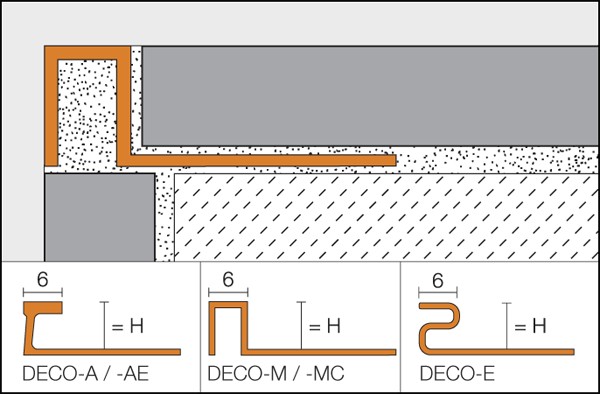
Schlüter DECO is available:
E = stainless steel
A = aluminum
AE = natural matt anodized aluminum
M = brass
MC = chrome brass
Material properties and application fields:
In certain cases, the suitability of the type of material must be checked according to the expected chemical or mechanical damage.
DECO-M brass profiles are resistant to practically all chemicals, which are commonly used in combination with ceramic coatings. The action of the air causes the brass to appear an oxide layer on the exposed surfaces, which provides a patina to the surface. The effects of humidity or aggressive substances can generate further oxidation and the formation of stains on the surface of the profile.
DECO-MC chrome-plated brass profiles are especially suitable for cladding, e.g. ex. in combination with chrome bathroom fittings. Visible surfaces must be protected from abrasions. The remains of mortar or grouting material must be removed immediately.
DECO-E stainless steel profiles are made of stainless steel strips, V2A (material 1.4301). Stainless steel is highly resistant to mechanical damage and is especially suitable for areas that require high resistance to chemical products, such as in acid and alkaline environments, as well as in areas where aggressive cleaning products are used. Stainless steel does not resist all chemical attacks such as hydrochloric acid, hydrofluoric acid and concentrations of salts. Special attacks must be checked before the profiles are installed.
In the case of Schlüter DECO-A aluminum profiles, it is advisable to check their suitability in those cases where a chemical attack is expected. Aluminum is sensitive to alkaline substances. Materials that contain cement in combination with humidity have an alkaline effect and, depending on the concentration level and the exposure time, can cause corrosion (formation of aluminum hydroxide). Mortar or grouting material must be removed immediately from visible areas. The profile must be in contact with the tile in its entirety, to avoid the accumulation of alkaline water.
Schlüter DECO-AE natural matt anodized aluminum profiles have a matt surface thanks to their anodized coating, which undergoes no changes under normal conditions of use. The surface must be protected from abrasive or scratching objects. Aluminum is sensitive to alkaline media. Materials containing cement act in combination with humidity in an alkaline way and can cause corrosion depending on the concentration level and the exposure time (formation of aluminum hydroxide). Therefore, any remaining mortar or grouting material should be removed from the surfaces immediately. The newly placed coatings, do not know.
Installation
- Select Schlüter DECO according to the tile thickness.
- Using a notched trowel, apply tile adhesive to the area where the tile covering will end or where a decorative joint element is to be placed.
- Press the trapezoid-perforated anchoring leg of Schlüter DECO firmly into the adhesive and align it.
- Trowel additional tile adhesive over the trapezoid-perforated anchoring leg to ensure full coverage, filling all chambers of the profile.
- Firmly press the adjoining tiles into place and align them in such a way that the upper profile edge is flush with the tile (the profile should not protrude over the surface of the covering; preferably, it should be approx. 1 mm below the top level of the covering). The tiles must be fully embedded in the area of the profile.
- Leave a joint of approx. 2 mm between the tile and the profile and fill it completely with grout.
Maintenance
Schlüter DECO requires no special maintenance or care. Do not use abrasive cleaning agents on the sensitive surfaces. The oxidation layer on brass or aluminium can be removed by using a conventional polishing agent, but will form again. Damage to the anodised surfaces can be restored with paint. The surfaces of stainless steel profiles can be polished with commercial chrome polishing products. Stainless steel surfaces exposed to the environment or aggressive substances should be cleaned periodically using a mild household cleaner. Regular cleaning maintains the neat appearance of stainless steel and reduces the risk of corrosion. All cleaning agents must be free of hydrochloric and hydrofluoric acid.
Avoid contact with other metals, such as regular steel, to prevent corrosion. This also includes installation tools such as trowels or steel wool, e.g. for the removal of mortar residue. We recommend the use of the stainless steel cleaning polish Schlüter CLEAN-CP.

